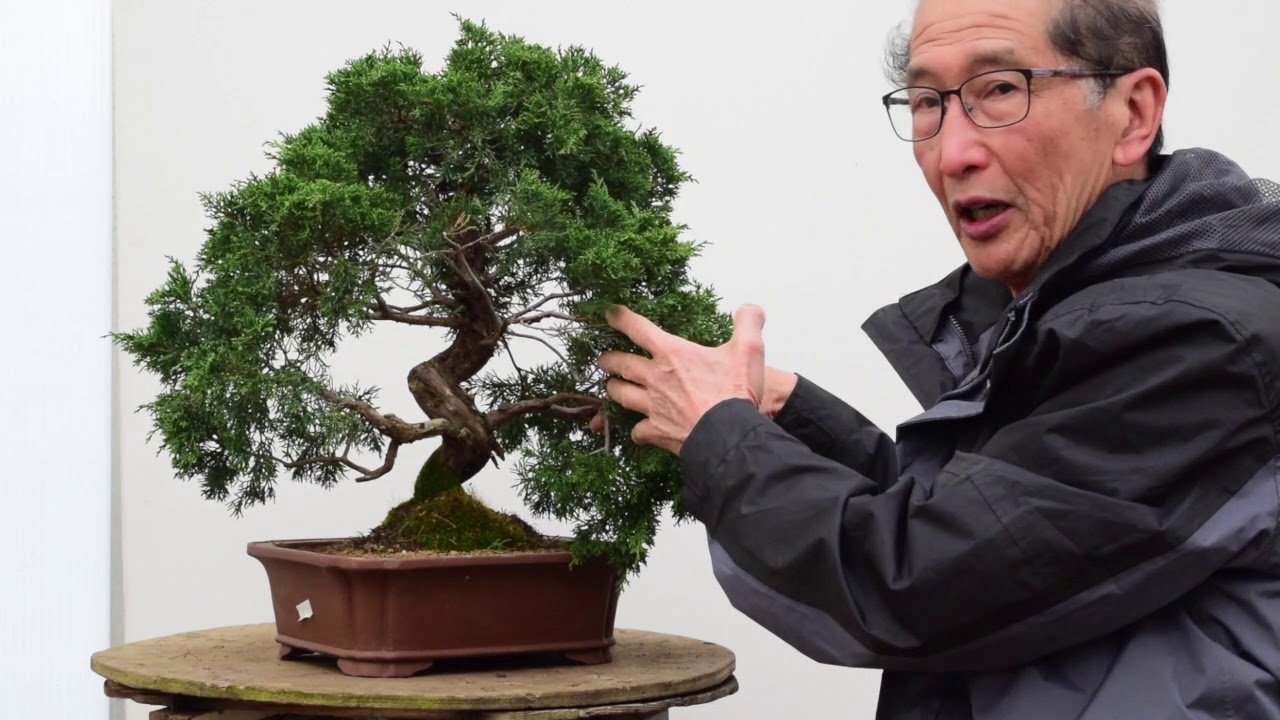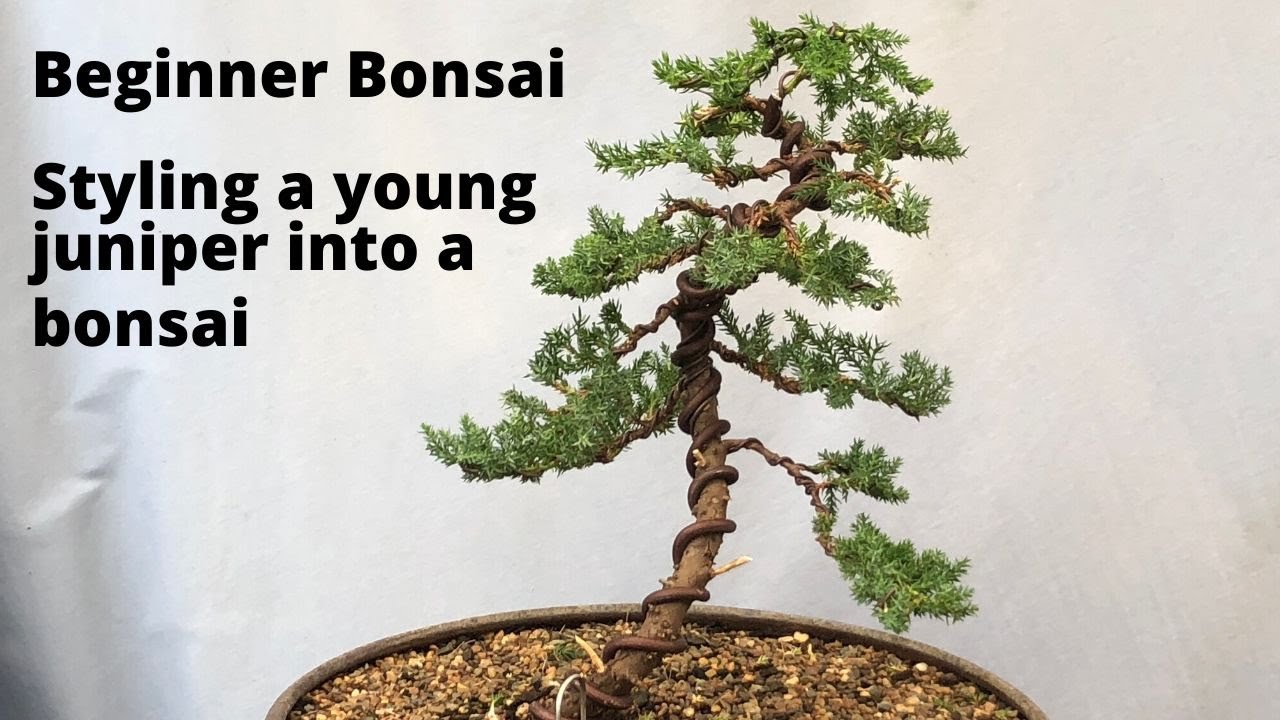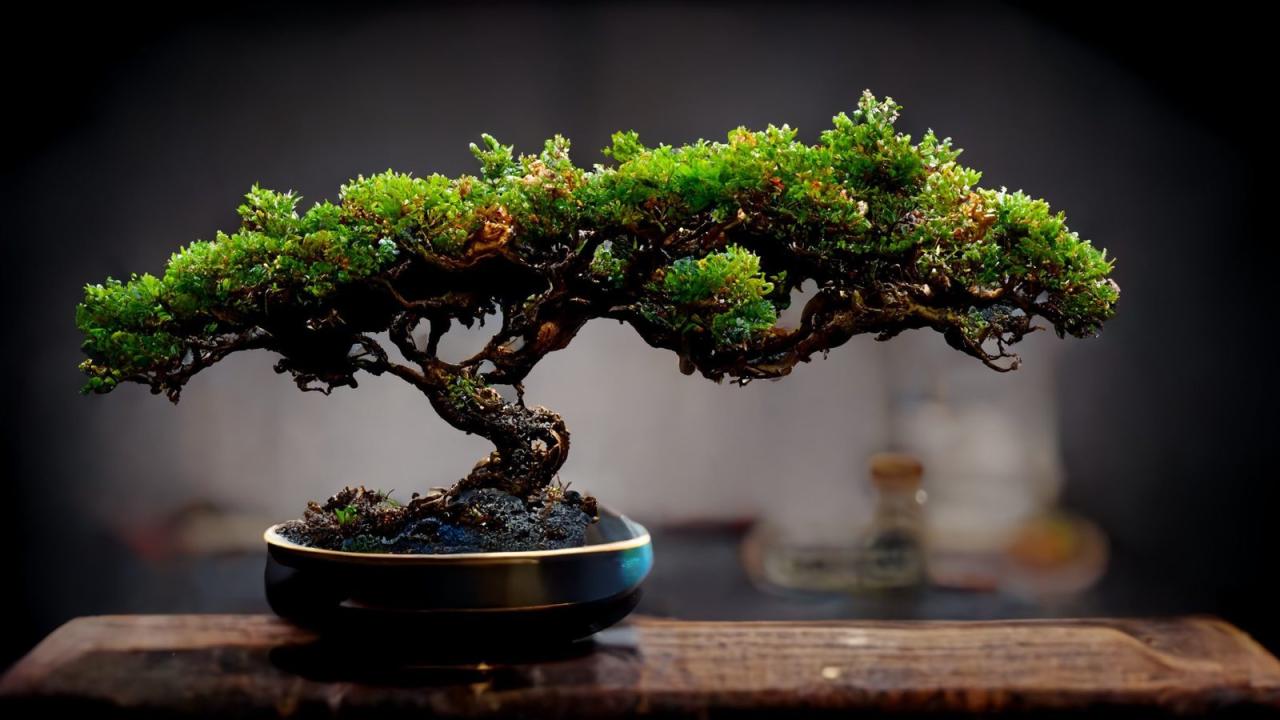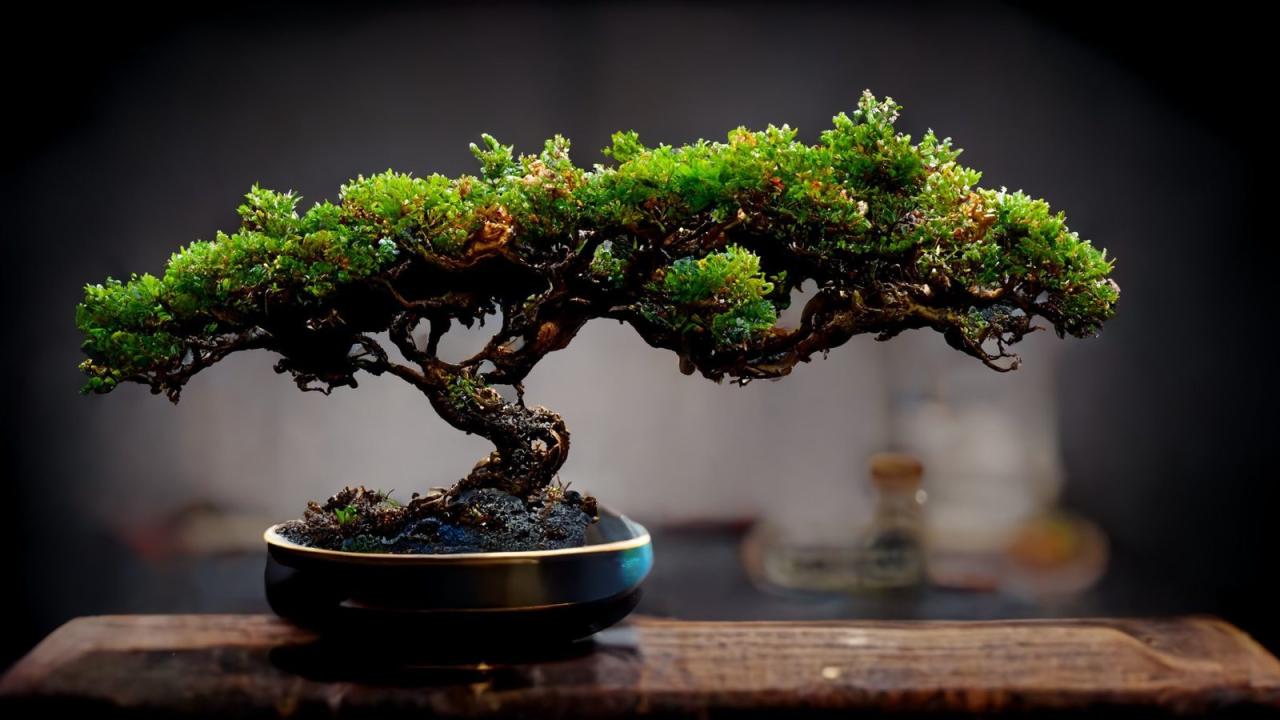How To Shape Your Juniper Bonsai Like A Pro – Juniper bonsai, with their rugged beauty and intricate forms, are a captivating testament to the artistry of bonsai cultivation. These resilient trees offer a unique challenge and reward for bonsai enthusiasts, allowing them to sculpt living masterpieces that reflect both nature’s grace and the artist’s vision.
Whether you’re a seasoned bonsai practitioner or a curious beginner, the allure of Juniper bonsai lies in its ability to transform a humble plant into a breathtaking work of art.
This comprehensive guide will delve into the fascinating world of Juniper bonsai, providing a roadmap for shaping and nurturing these remarkable trees. From selecting the right Juniper species to mastering advanced techniques, we’ll explore the essential steps to crafting a bonsai that is both visually stunning and a source of lasting satisfaction.
Introduction to Juniper Bonsai

Juniper bonsai trees are a popular choice for bonsai enthusiasts due to their unique characteristics and adaptability. Their rugged beauty, resilience, and versatility make them an excellent subject for creating stunning miniature landscapes.Juniper bonsai trees are known for their distinctive foliage, which can range from delicate, needle-like leaves to thicker, scale-like leaves.
This variety allows for a wide range of styles and shapes, making them suitable for both beginners and experienced bonsai artists. Their adaptability to various climates and growing conditions further contributes to their popularity.
Popularity and Appeal of Juniper Bonsai
Juniper bonsai trees are highly sought after for their aesthetic appeal and the sense of tranquility they evoke. Their ability to withstand harsh conditions and their long lifespan make them a symbol of resilience and longevity. The intricate details of their branches, needles, and bark create a captivating miniature world that can be enjoyed for years to come.
History and Cultural Significance of Juniper Bonsai
The art of bonsai, including the cultivation of juniper bonsai, has a rich history that dates back centuries in Japan. Juniper trees have been traditionally revered in Japanese culture for their symbolic meaning. They represent strength, longevity, and resilience, making them a popular choice for bonsai trees.The practice of bonsai cultivation is believed to have originated in China, where it was known as “penjing.” It was later introduced to Japan, where it evolved into a distinct art form.
Juniper bonsai trees have played a significant role in the development of bonsai culture, influencing techniques and aesthetics.The cultural significance of juniper bonsai is reflected in its use in traditional ceremonies, gardens, and homes. They are often considered to be a symbol of good luck and prosperity.
Selecting the Right Juniper

Choosing the right juniper species is crucial for successful bonsai development. Different species exhibit unique growth habits, foliage types, and bark characteristics, influencing their suitability for specific bonsai styles. Understanding these variations will help you select the best juniper for your desired bonsai creation.
Juniper Species Characteristics
The following table summarizes the key characteristics of popular juniper species commonly used for bonsai:
Species |
Growth Habit |
Foliage |
Bark |
Bonsai Style Suitability |
|---|---|---|---|---|
Juniperus chinensis (Chinese Juniper) |
Fast-growing, upright to spreading |
Green, blue-green, or golden-green needles; scale-like leaves on mature branches |
Reddish-brown, flaking, and textured |
Wide range of styles, including upright, cascading, and informal upright |
Juniperus procumbens (Creeping Juniper) |
Slow-growing, prostrate, and spreading |
Short, needle-like leaves; dense, compact growth |
Gray-brown, rough, and textured |
Suitable for rock-planting, cascade, and semi-cascade styles |
Juniperus virginiana (Eastern Red Cedar) |
Fast-growing, upright to spreading |
Green, blue-green, or golden-green needles; scale-like leaves on mature branches |
Reddish-brown, fibrous, and deeply furrowed |
Ideal for upright, informal upright, and literati styles |
Juniperus sabina (Savin Juniper) |
Slow-growing, spreading, and shrubby |
Short, needle-like leaves; blue-green or gray-green foliage |
Reddish-brown, peeling, and textured |
Suitable for cascade, semi-cascade, and informal upright styles |
Choosing the Right Juniper Based on Experience Level
- Beginners: Juniperus chinensis(Chinese Juniper) is an excellent choice due to its fast growth rate, adaptability, and ease of training. Its resilience makes it suitable for beginners who are learning the fundamentals of bonsai.
- Intermediate Bonsai Enthusiasts: Juniperus procumbens(Creeping Juniper) offers a challenge with its slow growth rate and unique spreading habit. It is well-suited for intermediate bonsai practitioners seeking to develop their skills in shaping and refining intricate designs.
- Advanced Bonsai Artists: Juniperus virginiana(Eastern Red Cedar) is a demanding species requiring patience and experience. Its fast growth rate and strong branching structure allow for creating elaborate and dynamic bonsai forms, appealing to advanced bonsai enthusiasts.
Juniper Species Recommendations for Specific Bonsai Styles
- Upright Styles: Juniperus chinensis(Chinese Juniper) and Juniperus virginiana(Eastern Red Cedar) are ideal for upright styles due to their strong vertical growth and ability to create a prominent central trunk.
- Cascading Styles: Juniperus procumbens(Creeping Juniper) and Juniperus sabina(Savin Juniper) are well-suited for cascading styles, with their naturally spreading and drooping branches that create a graceful, flowing effect.
- Informal Upright Styles: Juniperus chinensis(Chinese Juniper) and Juniperus sabina(Savin Juniper) are versatile options for informal upright styles, allowing for a more natural and relaxed appearance.
Basic Bonsai Techniques for Juniper
Juniper bonsai, known for their rugged beauty and resilience, require specific techniques to shape and maintain their unique forms. Mastering these techniques is crucial for creating stunning bonsai that reflect the natural elegance of these trees.
Pruning
Pruning is essential for controlling the growth of your juniper bonsai and shaping it into your desired form. Juniper bonsai can tolerate heavy pruning, but it’s important to understand the different types of pruning and their purposes.
- Pinch Pruning: This technique involves removing the growing tips of branches, encouraging bushier growth and finer foliage. Pinch pruning is best done in the spring and summer when the tree is actively growing.
- Cutting Back: This method involves removing larger branches or sections of branches to create specific shapes or reduce the overall size of the tree. Cutting back is usually done in the dormant season (winter) when the tree is not actively growing.
- Selective Pruning: This technique involves removing specific branches to create desired shapes or to remove branches that are growing in undesirable directions. Selective pruning can be done throughout the year, but it’s best to avoid heavy pruning during the active growing season.
Wiring
Wiring is a crucial technique used to shape and bend branches of your juniper bonsai. This process involves wrapping the branches with wire to guide their growth into desired positions. Juniper bonsai are known for their flexibility, making them suitable for wiring.
- Types of Wire: Different types of wire are used for bonsai, depending on the size and thickness of the branches. Aluminum wire is commonly used for juniper bonsai due to its flexibility and durability.
- Wire Application: Wire should be applied carefully to avoid damaging the bark. It’s important to ensure the wire is securely attached to the branch and to remove it before it cuts into the bark.
- Time of Wiring: The best time to wire a juniper bonsai is during the dormant season when the tree is not actively growing. This minimizes stress on the tree.
Defoliation
Defoliation, the process of removing leaves from a bonsai, is a technique used to encourage new growth and to refine the foliage of your juniper bonsai. It can be done in various ways, depending on the desired effect and the time of year.
- Partial Defoliation: This involves removing a portion of the leaves, usually on older growth, to encourage new growth. It’s often done in the spring to stimulate new growth.
- Full Defoliation: This involves removing all the leaves from the tree, usually done in the summer when the tree is actively growing. It’s a more drastic technique that can be used to create a denser foliage.
Soil
The right soil is crucial for the health and well-being of your juniper bonsai. Juniper bonsai thrive in well-draining soil that allows for adequate aeration.
A suitable soil mix for juniper bonsai consists of a combination of akadama, pumice, and lava rock.
Watering
Juniper bonsai require regular watering, but overwatering can lead to root rot. It’s important to check the soil moisture before watering. The frequency of watering will depend on the size of the pot, the climate, and the time of year.
- Watering Frequency: During the growing season, juniper bonsai should be watered more frequently than during the dormant season.
- Watering Technique: Water thoroughly until water drains out of the drainage holes. Allow the soil to dry slightly between waterings.
Fertilization
Fertilizing your juniper bonsai is essential for providing the necessary nutrients for healthy growth. Juniper bonsai should be fertilized regularly during the growing season.
- Fertilizer Type: A balanced fertilizer formulated for bonsai trees is recommended.
- Fertilization Frequency: Fertilize your juniper bonsai every 2-3 weeks during the growing season.
Repotting
Repotting is a necessary process for juniper bonsai to provide them with fresh soil and to maintain their health. It’s usually done every 2-3 years, depending on the growth rate of the tree and the size of the pot.
- Prepare the New Pot: Choose a pot that is slightly larger than the current pot. Ensure the pot has drainage holes.
- Remove the Bonsai from the Old Pot: Gently tap the bottom of the pot to loosen the tree.
- Clean the Roots: Remove any excess soil from the roots.
- Prune the Roots: Trim any damaged or circling roots.
- Place the Bonsai in the New Pot: Position the tree in the center of the new pot, ensuring that the root ball is slightly above the rim of the pot.
- Add Soil: Fill the pot with fresh soil, leaving a small space at the top for watering.
- Water Thoroughly: Water the tree thoroughly to settle the soil.
Creating Classic Bonsai Styles
Juniper bonsai are highly adaptable to various styles, allowing for artistic expression and the creation of miniature landscapes. Each style has unique characteristics and techniques, transforming the juniper into a miniature masterpiece.
Common Juniper Bonsai Styles
The following table Artikels the common juniper bonsai styles, their characteristics, and techniques:
Style |
Characteristics |
Techniques |
Example |
|---|---|---|---|
Upright (Chokkan) |
|
|
|
Cascade (Kengai) |
|
|
|
Slanting (Shakan) |
|
|
|
Informal Upright (Moyogi) |
|
|
|
Techniques for Shaping Juniper Bonsai
- Pruning:This involves removing branches and foliage to shape the tree and control its growth.
- Wiring:Using aluminum or copper wire to bend and shape branches, creating desired curves and angles.
- Root Pruning:Trimming the roots to encourage the growth of a dense root system and maintain the tree’s health.
- Repotting:Periodically transferring the bonsai to a new pot to refresh the soil and provide adequate drainage.
Choosing the Right Style for Your Juniper
- Consider the juniper’s natural growth habit:Some junipers have a naturally upright growth habit, while others have a more cascading form. This can guide your choice of style.
- Think about the space you have available:A cascading style may require more space than an upright style.
- Let your creativity flow:Ultimately, the best style for your juniper is the one that speaks to your artistic vision.
Advanced Techniques for Juniper Bonsai: How To Shape Your Juniper Bonsai Like A Pro

Once you have mastered the fundamentals of juniper bonsai, you can explore advanced techniques that elevate your artistry and create stunning, lifelike trees. These techniques involve manipulating the natural growth of the juniper to create unique and captivating forms.
Jin and Shari Creation
Jin and shari are essential elements in bonsai that mimic the effects of age and weathering on a tree. They add depth and realism to the bonsai, creating a sense of history and resilience.
- Jinrefers to dead branches that have been stripped of their bark, revealing the underlying wood. They are typically created on the upper branches of the bonsai, giving the impression of windswept or sun-scorched branches.
- Sharirefers to a dead section of trunk or branch that has been exposed by the stripping of bark and wood. This creates a dramatic visual effect and often enhances the bonsai’s overall design.
Creating jin and shari requires patience and precision. It’s important to use specialized tools, such as a sharp knife or a wire brush, to carefully remove the bark and wood. The process should be gradual, as removing too much at once can damage the bonsai.
Using Specialized Tools and Materials for Advanced Shaping
Advanced bonsai shaping often requires specialized tools and materials that allow for precise manipulation of the juniper’s growth.
- Wire: Different gauges of wire are used to bend and shape branches, creating curves and angles. Aluminum wire is often preferred for juniper bonsai due to its flexibility and resistance to rust.
- Pruning shears: These tools are essential for trimming branches and maintaining the bonsai’s desired shape. Different types of pruning shears are available, each designed for specific tasks.
- Bonsai soil: Specialized bonsai soil mixes provide excellent drainage and aeration, crucial for the health and growth of the juniper.
- Fertilizers: Juniper bonsai require regular fertilization to ensure their healthy growth and development.
Achieving Realistic and Artistic Effects
To achieve realistic and artistic effects in juniper bonsai, it’s essential to understand the natural growth patterns and characteristics of the juniper species. Observing the growth of junipers in their natural habitat can provide inspiration for bonsai design.
- Branch placement: Branches should be positioned in a way that mimics the natural growth patterns of the juniper. Consider the direction of sunlight, wind, and gravity when placing branches.
- Leaf density: The density of leaves can influence the overall visual impact of the bonsai. Use pruning techniques to create areas of dense foliage and sparse foliage, adding visual interest and depth.
- Texture: The bark of the juniper can be manipulated to create a variety of textures. This can be achieved through techniques such as jin and shari creation, as well as by using wire to bend and twist the branches.
Troubleshooting Common Juniper Bonsai Issues
Even with the best care, Juniper bonsai can encounter problems. Recognizing and addressing these issues promptly is crucial for maintaining the health and beauty of your tree. Regular inspection and preventative measures can help you avoid serious complications and ensure your Juniper thrives.
Pests
Pests can damage your Juniper bonsai by feeding on leaves, stems, or roots. Some common pests include:
- Juniper Scale:These tiny insects suck sap from the tree, causing yellowing and defoliation. They are often found clustered on the underside of leaves and branches.
- Spider Mites:These microscopic pests also feed on sap, leaving behind fine webbing and causing discoloration.
- Aphids:These small, pear-shaped insects suck sap and can cause leaf curling and stunted growth.
- Mealybugs:These pests are covered in a white, waxy substance and can cause damage similar to aphids.
Solutions:
Mastering the art of shaping a juniper bonsai involves a deep understanding of its unique characteristics. From pruning techniques to proper wiring, every step requires meticulous attention to detail. To ensure your bonsai thrives, it’s crucial to learn about the essential care practices for both indoor and outdoor varieties, as outlined in Bonsai Care Tips for Indoor and Outdoor Bonsai Trees.
Armed with this knowledge, you’ll be well-equipped to shape your juniper bonsai into a breathtaking miniature masterpiece that reflects the beauty of nature.
- Hand-picking:For small infestations, hand-picking pests can be effective.
- Insecticidal soap:This is a safe and effective treatment for many pests, but it may need to be applied multiple times.
- Neem oil:This natural oil is a good preventative measure and can also help control existing infestations.
- Beneficial insects:Introducing predatory insects like ladybugs or lacewings can help control pest populations.
Prevention:
- Regular inspection:Check your Juniper bonsai regularly for signs of pests.
- Good sanitation:Remove fallen leaves and debris to prevent pests from hiding.
- Proper watering:Avoid overwatering, which can weaken the tree and make it more susceptible to pests.
Diseases
Juniper bonsai can be affected by various diseases, including fungal and bacterial infections.
- Root Rot:This fungal disease is caused by overwatering and poor drainage. Symptoms include wilting, yellowing, and leaf drop.
- Canker:This fungal infection causes sunken, dead areas on the bark and branches.
- Rust:This fungal disease can cause yellowing and browning of leaves and needles.
- Blight:This bacterial infection can cause browning and death of needles.
Solutions:
- Pruning:Remove any infected branches or needles.
- Fungicides:Applying a fungicide can help control fungal diseases.
- Antibiotics:Bacterial infections may require treatment with antibiotics.
Prevention:
- Proper watering:Ensure good drainage and avoid overwatering.
- Sterile tools:Use clean, sterilized tools for pruning and other maintenance.
- Good air circulation:Avoid overcrowding and ensure good airflow around your Juniper bonsai.
Growth Abnormalities, How To Shape Your Juniper Bonsai Like A Pro
Juniper bonsai can experience growth abnormalities due to various factors.
- Stunted growth:This can be caused by poor soil, lack of nutrients, or insufficient light.
- Uneven growth:This can be caused by improper pruning or exposure to too much direct sunlight.
- Leaf drop:This can be caused by overwatering, underwatering, or stress.
Solutions:
- Repotting:If the soil is poor or compacted, repotting with fresh, well-draining soil can help.
- Fertilizing:Use a balanced fertilizer to provide essential nutrients.
- Adjusting light exposure:Ensure your Juniper bonsai receives adequate light but avoid excessive direct sunlight.
- Pruning:Remove any dead or damaged branches to encourage healthy growth.
Prevention:
- Proper care:Provide adequate light, water, and nutrients.
- Regular inspection:Monitor your Juniper bonsai for any signs of growth abnormalities.
- Stress reduction:Minimize stress by providing a stable environment and avoiding drastic changes.
Importance of Regular Inspection and Maintenance
Regular inspection and maintenance are essential for maintaining the health of your Juniper bonsai. By checking your tree for signs of pests, diseases, or growth abnormalities, you can address issues early on and prevent them from escalating.
- Visual inspection:Regularly examine your Juniper bonsai for any signs of damage, discoloration, or unusual growth.
- Touch and feel:Check the texture of leaves and needles for any signs of pests or disease.
- Soil moisture:Monitor soil moisture levels to avoid overwatering or underwatering.
Early detection and treatment are crucial for successful bonsai care. Regular inspection and maintenance allow you to catch problems before they become serious, ensuring the longevity and beauty of your Juniper bonsai.
Inspiration and Resources for Juniper Bonsai
The journey of shaping a Juniper bonsai is a lifelong endeavor, filled with challenges and rewards. It’s a testament to patience, dedication, and the unwavering pursuit of beauty. To guide you on this path, we’ll delve into the wisdom of renowned bonsai masters and explore valuable resources for further learning.
Inspirational Quotes from Bonsai Masters
The art of bonsai is rooted in the philosophy of finding beauty in the miniature, reflecting the grandeur of nature in a small scale. Bonsai masters have articulated this profound concept in their own unique ways.
“Bonsai is not about making a tree small, but about making it look old.”
Mastering the art of shaping a juniper bonsai requires a delicate balance of pruning, wiring, and patience. Before you can sculpt your juniper into a masterpiece, it’s essential to understand the fundamental principles of bonsai care, ensuring your tree thrives.
For comprehensive guidance on the best practices for keeping your bonsai healthy and vibrant, check out this helpful resource on Bonsai Care Tips: How to Keep Your Tree Flourishing. Once your juniper is thriving, you can confidently begin shaping its branches and foliage, creating a miniature masterpiece that will be the envy of any bonsai enthusiast.
Masakuni Kobayashi
“Bonsai is not a hobby, it is a way of life.”
John Naka
“Bonsai is the art of creating a living sculpture, a miniature landscape that reflects the essence of nature.”
Walter Pall
Recommended Resources for Further Learning
The world of bonsai offers a wealth of knowledge, waiting to be explored. These resources will provide you with the tools and guidance to enhance your skills and deepen your understanding of Juniper bonsai.
Books
- “Bonsai: An Illustrated Encyclopedia” by Peter Adams– A comprehensive guide covering various aspects of bonsai, including Juniper care and styling.
- “The Art of Bonsai” by John Yoshio Naka– A classic text that delves into the philosophy and techniques of bonsai, with specific insights on Juniper species.
- “The Bonsai Handbook” by Harry Tomlinson– A practical guide that offers detailed instructions on Juniper care, pruning, and shaping.
Websites
- American Bonsai Society (ABS):www.bonsai.org – A leading organization dedicated to promoting bonsai in the United States, providing resources, and connecting enthusiasts.
- Bonsai Today:www.bonsaitoday.com – A comprehensive website featuring articles, videos, and tutorials on all aspects of bonsai, including Juniper care.
- International Bonsai Federation (IBF):www.ibf-bonsai.org – A global organization that fosters international collaboration and promotes the art of bonsai worldwide.
Online Communities
- Bonsai Reddit:www.reddit.com/r/bonsai – A vibrant online community where enthusiasts share their knowledge, ask questions, and showcase their bonsai.
- Bonsai Forum:www.bonsai-forum.com – A dedicated forum for bonsai discussions, covering a wide range of topics, including Juniper care and styling.
- Bonsai Clubs International:www.bonsai-clubs.org – A network of bonsai clubs worldwide, offering opportunities for learning, sharing, and connecting with fellow enthusiasts.
Reputable Suppliers of Juniper Bonsai Trees and Accessories
To embark on your Juniper bonsai journey, you’ll need quality trees and the right tools. These reputable suppliers offer a wide selection of Juniper bonsai trees and accessories to meet your needs.
Bonsai Trees
- Bonsai Boy:www.bonsaiboy.com – A well-established online retailer specializing in high-quality bonsai trees, including Juniper species.
- The Bonsai Outlet:www.bonsaioutlet.com – A reputable supplier offering a diverse range of bonsai trees, including Juniper, at competitive prices.
- Eastwind Bonsai:www.eastwindbonsai.com – A leading bonsai nursery known for its extensive selection of Juniper trees and expert care.
Accessories
- Bonsai Jack:www.bonsaijack.com – A dedicated supplier of bonsai tools, pots, and accessories, catering to both beginners and experienced enthusiasts.
- The Bonsai Store:www.bonsaistore.com – A comprehensive online retailer offering a wide selection of bonsai tools, fertilizers, and other essential supplies.
- Amazon:www.amazon.com – A vast online marketplace offering a wide range of bonsai tools, pots, and accessories from various suppliers.
Last Point
As you embark on your journey into the world of Juniper bonsai, remember that patience, dedication, and a deep appreciation for the natural beauty of these trees are key. By following the principles Artikeld in this guide and embracing the process of nurturing and shaping your Juniper, you’ll not only create a breathtaking bonsai but also cultivate a connection with nature that is both enriching and fulfilling.
Let the artistry of bonsai guide you as you transform your Juniper into a living masterpiece, a testament to your dedication and the enduring beauty of these remarkable trees.
FAQ
What are the best tools for shaping Juniper bonsai?
Essential tools for shaping Juniper bonsai include bonsai shears, concave cutters, wire cutters, bonsai wire, and a variety of tweezers for precise work.
How often should I repot my Juniper bonsai?
Juniper bonsai typically require repotting every 2-3 years, depending on the growth rate and the size of the pot.
What are some common pests that affect Juniper bonsai?
Common pests include aphids, spider mites, and scale insects. Regular inspection and preventative measures are crucial.
